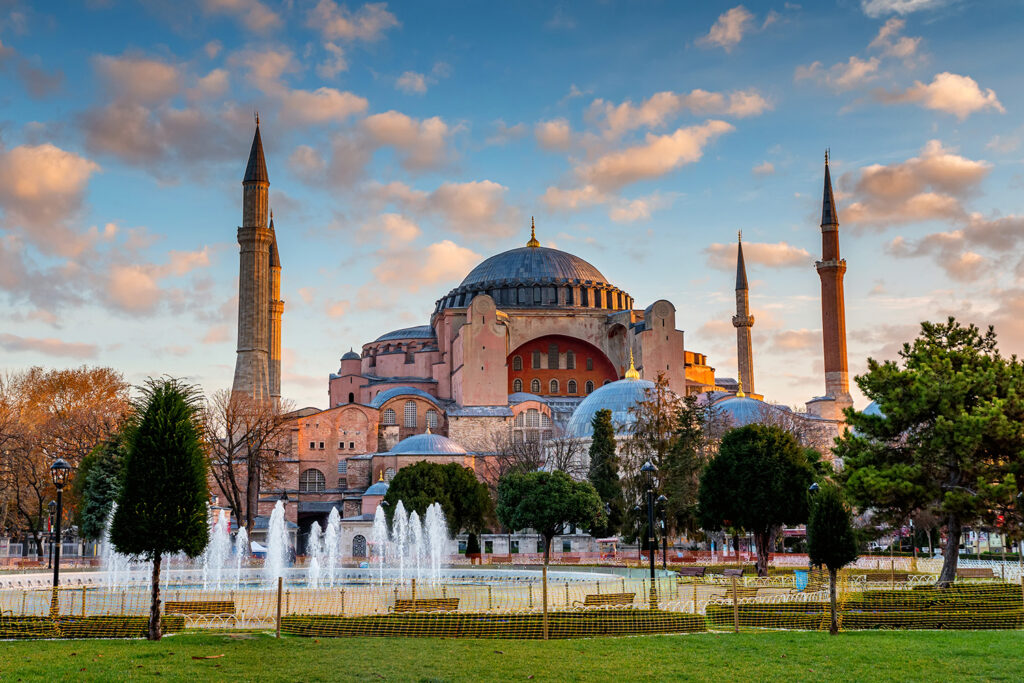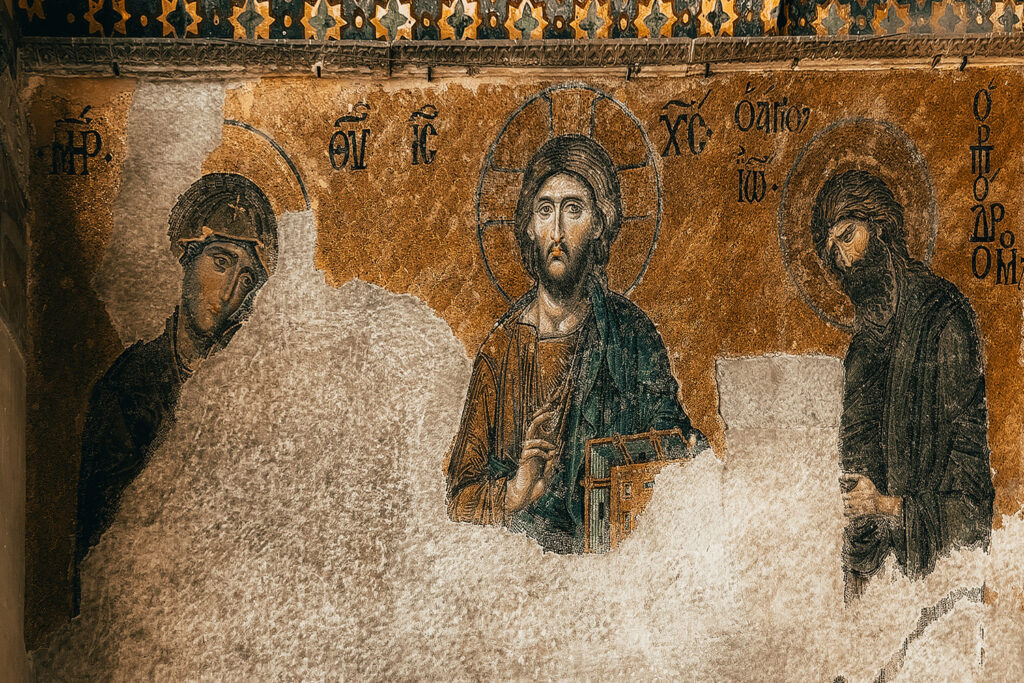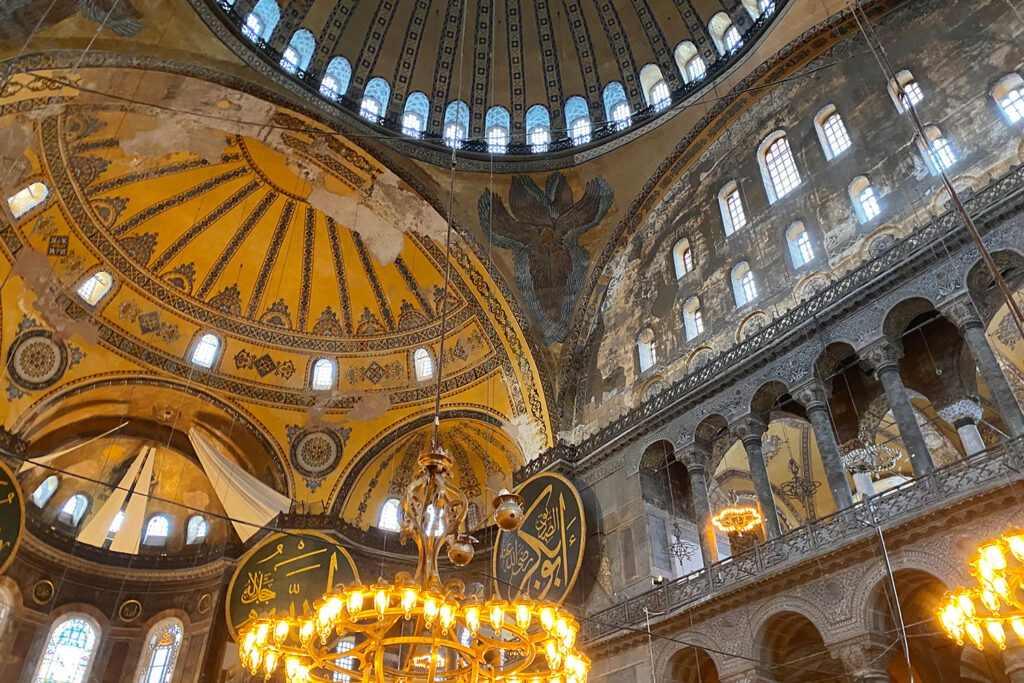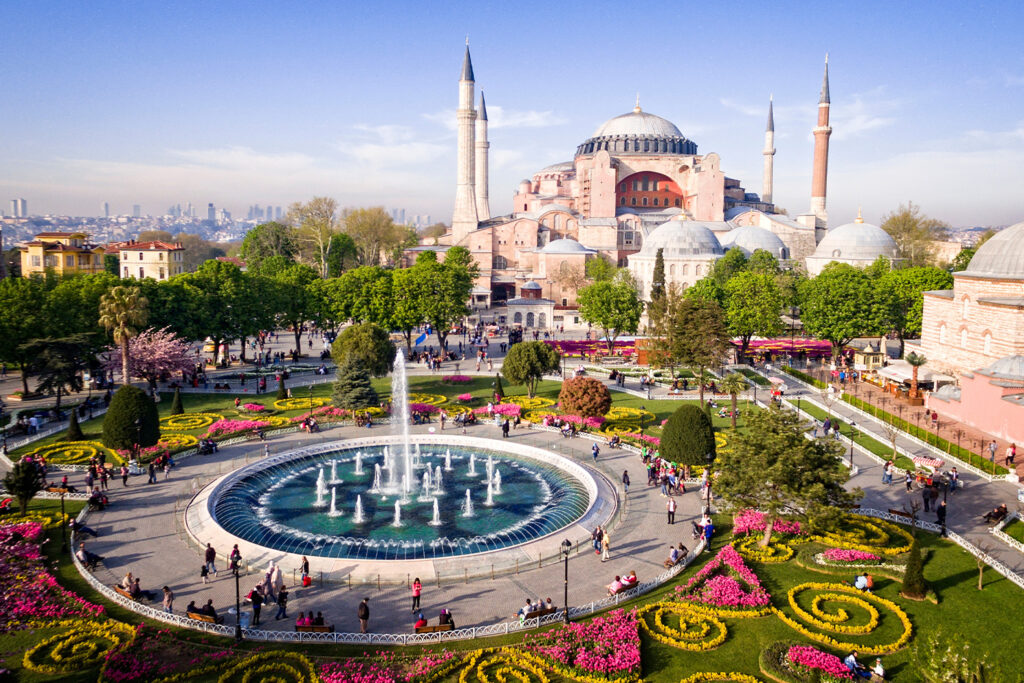One of the most frequently visited places in Istanbul is a temple where you can see both golden Christian mosaics and Islamic calligraphy under its dome.
Hagia Sophia, whose name can be translated as the Church of Holy Wisdom, is not only a functioning mosque in Turkey. Thanks to its architecture and its rich historical significance, it is primarily a remarkable relic of the past and one of the most important monuments in Turkey and the world. This mosque, inscribed on the UNESCO World Heritage List in 1985, was originally built as a church of the Eastern Roman Empire, and after more than 900 years, it became a jewel of the Muslim world and the grand mosque of the sultans.
This architectural gem is located in the heart of Istanbul, on the European side of the city, near the famous Topkapi Palace. It is separated from another popular tourist site, the Blue Mosque, by the beloved Sultan Ahmed Park, which is a favorite spot for both locals and visitors, with a very photogenic fountain marking its center.
Three temples in one place
To understand why such long queues form to enter this temple, you need to learn about its extraordinary history. As early as 360 AD, during the reign of Emperor Constantius II, the Megale Ekklesia, or Great Church, was built on the site of today’s structure. Little information about the appearance of the original building has survived, but we know it was covered by a wooden roof and had the form of a vertically extended basilica. However, this temple did not last long, as it was completely destroyed during public riots in 404.

At the initiative of Emperor Theodosius II, a second church was built on the same site in 415, which then took the name Hagia Sophia, meaning the Church of Holy Wisdom. Although this structure survived longer than its predecessor, it was also razed to the ground during the Nika revolt in 532.
The Hagia Sophia in its current form is the third building occupying this site. Its construction was ordered in 532 by Emperor Justinian the Great, and just five years later, it was grandly opened to the faithful. Architecturally, this new building was significantly different from its predecessors. It became a symbol of Byzantium and had a profound influence on the history of architecture.
In the first few decades of its existence, the church faced many challenges. During an earthquake in 558, the dome collapsed, and over the next few years, the building suffered damage from multiple fires, but each time it was repaired. The church remained the great Christian cathedral until the fall of Constantinople in 1453, when it was transformed into an imperial mosque. At that time, buttresses and four minarets were added to the structure, and most of the Christian mosaics and frescoes were covered with plaster. The bells, sacrificial vessels, and iconostasis also disappeared from the temple.
GOOD TO KNOW: Emperor Justinian the Great was actively involved in both planning the Hagia Sophia and solving its architectural challenges. According to popular legend, he gained his knowledge through conversations with an angel. Another legend linked to the Hagia Sophia and Justinian claims that during the church’s opening, the emperor exclaimed, “Solomon, I have surpassed you!”—aware that he had created a structure more magnificent than King Solomon’s Temple in Jerusalem.
Recent history of the mosque

Hagia Sophia served as a mosque until 1930, when its doors were closed. Four years later, it reopened to visitors, but not as an active mosque. By decision of the Council of Ministers, it was transformed into a museum. Turkey’s first president sought to honor the fact that although the structure had been a place of Muslim worship for nearly 500 years, it had also served Christians for more than 900 years.
This government decision was revisited in 2020, when—after 86 years—worship services were resumed in the mosque. Around 350,000 people participated in the reopening ceremony, celebrating the return to tradition with communal prayer. However, not everyone welcomed this change. Both Pope Francis and Ecumenical Patriarch Bartholomew I expressed sadness at the news. Despite this, Turkey’s president assured that the doors of this iconic place, regardless of its religious role, would remain open to all, irrespective of nationality or faith. All relics found within the Hagia Sophia are still safeguarded, and administrative responsibilities are currently shared between the Directorate of Religious Affairs in Turkey and the Ministry of Culture and Tourism.
Architecture of the Temple
When planning the construction of the Hagia Sophia, Emperor Justinian was particularly focused on creating the largest and most magnificent building of his time. To achieve this, he not only enhanced the basilica’s design with a grand central dome, but also ensured that only the finest building materials available were used. The columns were brought from Ephesus and Tarsus (some even from the Temple of Artemis in Ephesus), white marble came from the island of Marmara, and yellow marble from North Africa. Some even claim that the Imperial Gate was partially crafted from wood taken from Noah’s Ark…
Amidst the 104 columns, walls adorned with marble, mosaics, and an abundance of gold, it’s difficult to decide which element deserves the most attention. To help with that, here’s a small guide.
FUN FACT: Among the 104 columns inside the Hagia Sophia, one stands out as a particular tourist attraction. Known as the Weeping Column, it is said to bring good fortune to visitors. There’s a hole in the surface of the column, and legend has it that if you insert your thumb into the hole and manage to rotate your hand 360° with your fingers, and your thumb comes out slightly damp, your wish will come true. It is also believed that during the Byzantine era, this column had healing powers, curing people of ailments like headaches, stomach issues, and even malaria.
Interior of Hagia Sophia

The main hall of the mosque is its crown jewel. Looking upwards, you’ll see remnants of the frescoes that once adorned the ceiling, though their brilliance is overshadowed by the grand dome at the center. Originally, this 30-meter-wide dome featured an image of Christ, but today it is adorned with gilded verses from the Quran. As you lower your gaze, you’ll notice a circular, colorful pattern on the otherwise uniform floor, marking the exact spot where Byzantine emperors were crowned.
Among the treasures of the nave are marble urns, a distinct pulpit, and above all, numerous mosaics. For example, above the entrance gate is a mosaic depicting Christ Pantokrator, representing Jesus as the supreme ruler, while above the vestibule gate, you can find a representation of Mary and baby Jesus, flanked by Emperor Constantine and Emperor Justinian. The main apse is also adorned with an image of the Virgin Mary holding baby Jesus. Four mosaics of Seraphim, the angels guarding the throne of God, once protected the dome. Two of these have long been destroyed and were restored as paintings, while the other two surviving mosaics have been fully visible since 2009.
Calligraphic Medallions
The first thing likely to catch your attention upon entering the mosque won’t be the mosaics or the dome, but the distinctive round panels. These calligraphic medallions, hanging on the walls of the main hall, were introduced during renovations between 1847 and 1849 under Sultan Abdulmejid. The plaques were made from lightweight linden wood, each with a diameter of over 7 meters. What truly makes them stand out are their intricate decorations. The medallions are inscribed with the names of Allah, Muhammad, the first four caliphs, and the two grandsons of Muhammad in gold. These giant medallions are among the largest circular calligraphic pieces in the Islamic world.

Upper Gallery
A stroll through the upper gallery will reveal even more secrets of Hagia Sophia. This gallery primarily showcases a continuation of the stunning mosaics. The most famous artwork in this section is the Deesis mosaic, which depicts Christ flanked by the Virgin Mary on his left and John the Baptist on his right. In various parts of the gallery, you can also spot imperial portraits, such as the mosaic of Emperor Alexander and that of Empress Zoe.
For those with a keen eye, directly opposite the Deesis mosaic, you’ll notice a memorial marker. This is a tribute to Enrico Dandolo, the leader of the Fourth Crusade, who died in Istanbul in 1205. But the surprises don’t end there. If you take a closer look at the marble balustrades in the southern gallery, you’ll find an inscription left by a Viking soldier. The runic graffiti reads “Halvdan was here,” likely carved by a Viking soldier serving in the Byzantine army. Historians believe that there could be even more runic inscriptions hidden within Hagia Sophia’s walls, so during your visit, you might want to search for these remnants of the Viking presence.
Tickets and etiquette for visiting

Finding Hagia Sophia in Istanbul won’t be a challenge, but gaining entry to its interior might be, especially if you don’t purchase tickets in advance. Starting in January 2024, an entrance fee will be required, making Hagia Sophia the only mosque in Istanbul to implement such a policy. Additionally, tourists are currently only permitted to access the upper gallery, so unless you’re entering for prayer, you’ll only be able to view the main nave from above.
If you still wish to explore the interior of this architectural marvel, remember to purchase your tickets online, for example, through the GetYourGuide website. Although you’ll still need to queue for the security check (especially if you’re visiting Istanbul in the summer), you’ll save time by skipping the ticket office lines.
Since Hagia Sophia is still an active mosque, visiting is not allowed during prayer times. For the same reason, visitors must adhere to dress codes when entering. It’s not just about covering your shoulders and knees—women are also required to cover their hair. However, if you’re not fully prepared for your visit, there’s no need to worry; scarves and head coverings are available for a small fee at the entrance.
To learn all the details about the mosque’s rich history, you can use the QR codes along the way, which will direct you to audio guides. Alternatively, if you prefer leaving with no lingering questions, you can book a guided tour for a more in-depth experience.
GOOD TO KNOW: Just a 5-minute walk from Hagia Sophia, you’ll find Ibrahim Pasha Palace, home to the Hagia Sophia History & Experience Museum. This interactive museum delves into the fascinating stories surrounding Hagia Sophia and the various stages of its construction. If you leave the mosque with unanswered questions, you’ll find all the answers here.
Practical information
- It is best to purchase tickets for the Hagia Sophia in advance. This way, you can avoid standing in long lines and reduce the risk of tickets being sold out.
- Address: Sultan Ahmet, Ayasofya Meydanı No:1, 34122 Fatih/İstanbul, Turkey
- Buy tickets on GetYourGuide